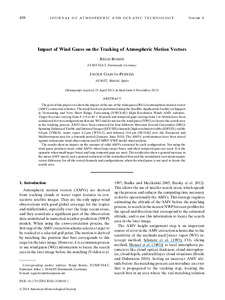Por favor, use este identificador para citar o enlazar este ítem:
http://hdl.handle.net/20.500.11765/1321
Impact of wind guess on the tracking of atmospheric motion vectors
Registro completo de metadatos
| Campo DC | Valor | Lengua/Idioma |
|---|---|---|
| dc.contributor.author | Borde, Régis | es_ES |
| dc.contributor.author | García Pereda, Javier | es_ES |
| dc.date.accessioned | 2016-03-15T11:09:48Z | - |
| dc.date.available | 2016-03-15T11:09:48Z | - |
| dc.date.issued | 2014 | - |
| dc.identifier.citation | Journal of Atmospheric and Oceanic Technology. 2014, 31(2) p. 458–467 | es_ES |
| dc.identifier.issn | 0739-0572 | - |
| dc.identifier.issn | 1520-0426 | - |
| dc.identifier.uri | http://hdl.handle.net/20.500.11765/1321 | - |
| dc.description.abstract | The goal of this paper is to show the impact of the use of the wind guess (WG) in atmospheric motion vector (AMV) extraction schemes. The study has been performed using the Satellite Application Facility on Support to Nowcasting and Very Short Range Forecasting (NWCSAF) High Resolution Winds AMV software. Target box sizes varying from 8 × 8 to 40 × 40 pixels and temporal gaps varying from 5 to 60 min have been considered for two configurations that use WG and do not use the wind guess (NWG) to locate the search area in the tracking process. AMVs have been extracted for four different Meteosat Second Generation (MSG) Spinning Enhanced Visible and Infrared Imager (SEVIRI) channels [high-resolution visible (HRVIS), visible 0.8 μm (VIS0.8), water vapor 6.2 μm (WV6.2), and infrared 10.8 μm (IR10.8)] over the European and Mediterranean area for a 6-month period (January–June 2010). The AMVs’ performances have been tested against radiosonde wind observations and ECMWF NWP model wind analysis. The results show an impact on the amount of valid AMVs extracted by each configuration. Not using the wind guess produces more valid AMVs when large target boxes and short temporal gaps are used. It is the opposite when small target boxes and long temporal gaps are used. The results also show a general increase in the mean AMV speed, and a general reduction of the normalized bias and the normalized root-mean-square vector difference for all the tested channels and configurations, when the wind guess is not used to locate the search area. | es_ES |
| dc.format | application/pdf | |
| dc.language.iso | eng | es_ES |
| dc.publisher | American Meteorological Society | es_ES |
| dc.subject | Wind guess | - |
| dc.subject | Atmospheric motion vector | - |
| dc.subject | Vector de movimiento atmosférico | es_ES |
| dc.subject | Observaciones de satélite | es_ES |
| dc.subject | Viento | es_ES |
| dc.title | Impact of wind guess on the tracking of atmospheric motion vectors | es_ES |
| dc.type | info:eu-repo/semantics/article | es_ES |
| dc.relation.publisherversion | http://dx.doi.org/10.1175/JTECH-D-13-00105.1 | es_ES |
| dc.rights.accessRights | info:eu-repo/semantics/openAccess | es_ES |
| Colecciones: | Artículos científicos 2010-2014 | |
Ficheros en este ítem:
| Fichero | Descripción | Tamaño | Formato | ||
|---|---|---|---|---|---|
| Paper_WindGuess_AMVs.pdf | 890,06 kB | Adobe PDF |  Visualizar/Abrir |
Los ítems de Arcimis están protegidos por una Licencia Creative Commons, salvo que se indique lo contrario.





